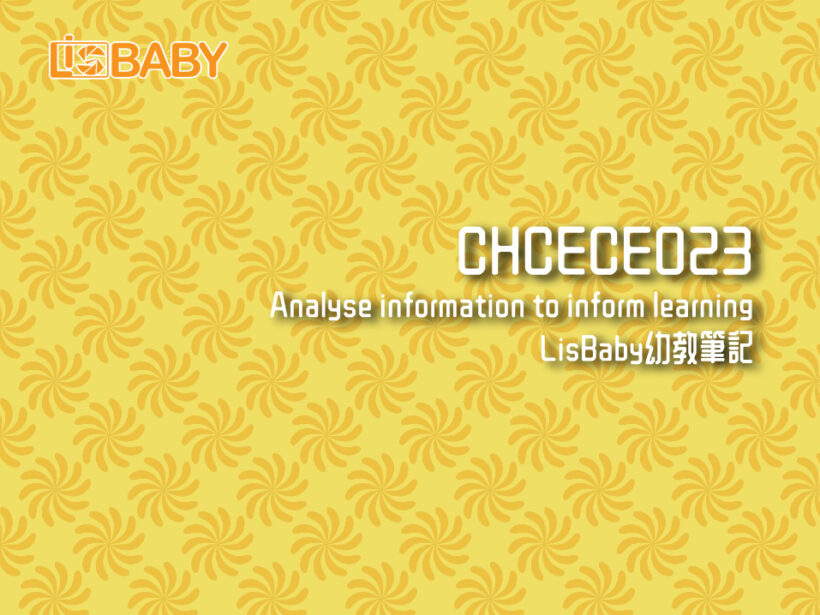關於 CHCECE023 Analyse information to inform learning 這個課題的重點,小編已經總結出來,如果大家有補充內容,歡迎留言區多多分享喔!!!
Their preferred learning style may be:
- Visual – the child learns best through visual aids, by looking at and seeing diagrams, pictures, charts, graphs.
- Auditory – the child learns best by listening to recordings, people talking, repetition, chanting/singing.
- Kinaesthetic – the child learns best through actively touching and feeling tangible objects and moving and doing practical activities.
- Reading-writing – the child learns best simply by reading information and writing it down.
- Play preferences – these will vary according to the age and the developmental stage of the child (see the table on the following page).
- Behaviour and responses to different situations, such as:
- Varying activities/lessons.
- Times of the day.
- Different educators/members of staff.
- Different settings.
- Collaboration with specific other children.
- Confrontation/conflict.
- Different emotional states such as disappointment, frustration, excitement, anger, fear, happiness, anxiety.
- Change and uncertainty.
- Strengths and abilities – physical, mental, emotional, social, and academic.
- Needs and learning difficulties which could include:
- Physical disabilities and medical conditions such as epilepsy, diabetes, juvenile rheumatoid arthritis, specific learning difficulties such as dyslexia, dyspraxia, dyscalculia, Irlen’s syndrome, autism, Asperger’s syndrome.
- Behavioural issues such as ADHD (Attention Deficit Hyperactive Disorder), ADD (Attention Deficit Disorder), ODD (Oppositional Defiance Disorder).
- Emotional and mental health issues.
- Attitude to learning – how enthusiastic the child is towards learning, their willingness to participate in individual and group activities, their desire to learn more and develop their knowledge and understanding.
- Interests – specific subject matter and curriculum areas as well as hobbies and social interests.
- Achievements – both within and outside of the learning/caring environment.
- Developmental stage and whether or not they are developing at the usual or expected rate.
Methods of observation might include:
- Running narrative – direct observation and taking notes.
- Taking photos of children engaged in activities (parental permission may be required).
- Video recording children engaged in activities (parental permission may be required).
- Audio tapes (parental permission may be required).
- Anecdotal narratives – ad hoc records of incidents and behaviours of children that detail what happened, why it happened, things that were said and done, etc.
- Time sampling – observing a specific behaviour over a period of time in the same and different settings.
- Rating scales – a child is observed and each pre-determined behaviour is scored by a scale such as:
- Not at all like the child.
- Somewhat unlike the child.
- Neither like nor unlike the child.
- Somewhat like the child.
- Very much like the child.
- Checklists that detail pre-determined behaviours, abilities, attitude towards learning, skills, achievements, strengths, play preferences.
List the five learning outcomes as stated by The Early Years Framework
- Children have a strong sense of identity.
- Children are connected with and contribute to their world.
- Children have a strong sense of wellbeing.
- Children are confident and involved learners.
- Children are effective communicators.
Collaborating with colleagues is essential in supporting children’s learning. List the ‘tips’ that help build positive relationships with colleagues.
- Listen and acknowledge ideas and feedback – Although an educator may have worked for a number of years in the education and care environment, there will always be different ideas and suggestions that co-workers may have; discussing any issues or concerns about programming, behavioural challenges and activities, with co-workers allows, for feedback and a new way of addressing issues.
- Offer help when needed – If a co-worker is struggling to deal with a situation, like an incessantly crying child, offer assistance; an extra hand will help get the situation under control.
- Encourage honest and open communication – All staffing issues need to be dealt with directly and promptly; staff should feel comfortable about discussing their issues and concerns with one another, without any feeling of intimidation.
- Offer support and advice – There will be times when fellow staff will need support, or advice, on a particular topic; it is important to collaborate with one another, and support each other in these circumstances.
【關於LisBaby旅食百變】
 訂閱“LisBaby旅食百變的YouTube頻道”看新片!
訂閱“LisBaby旅食百變的YouTube頻道”看新片! 追蹤“LisBaby旅食百變的Facebook專頁”了解最新動向!
追蹤“LisBaby旅食百變的Facebook專頁”了解最新動向! 更新“LisBaby旅食百變的網站”看新的文章吧!
更新“LisBaby旅食百變的網站”看新的文章吧! 歡迎商業合作請「聯絡我們」感謝!
歡迎商業合作請「聯絡我們」感謝!
喜歡我們的文章嗎?請like和share

